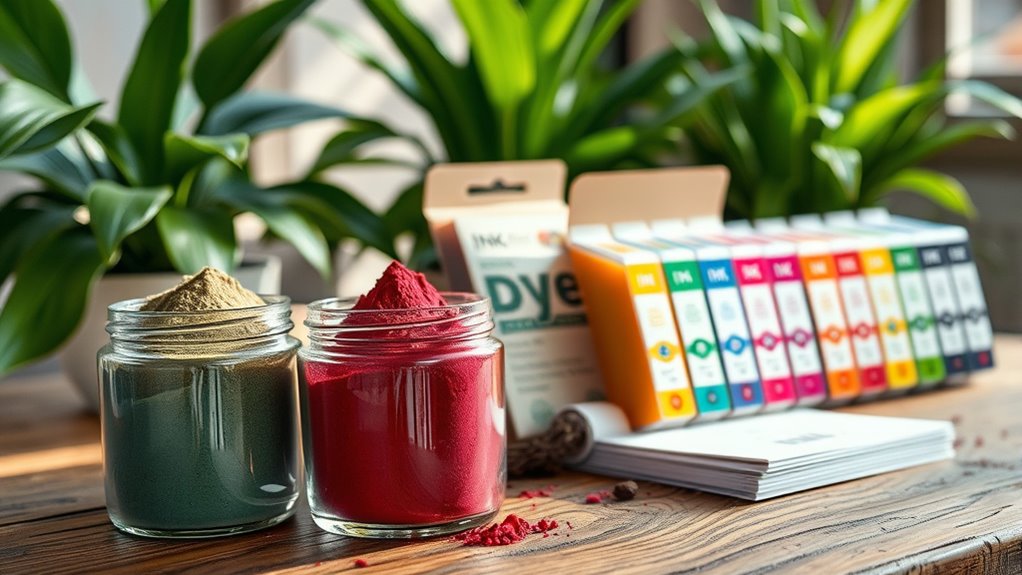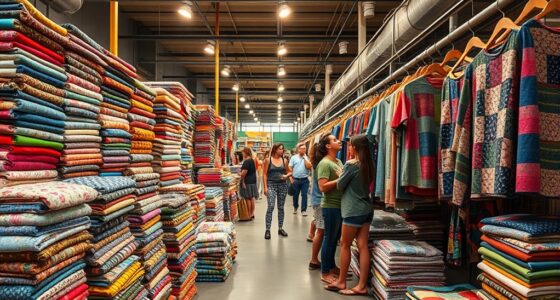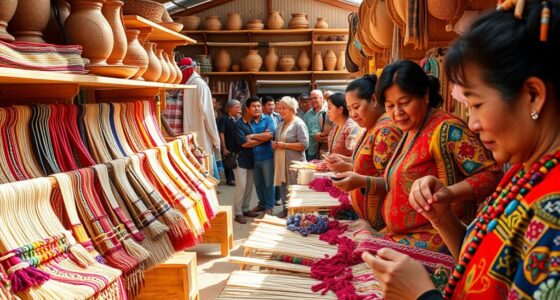Choosing responsible dyes and eco-friendly printing methods helps reduce your environmental impact. Natural dyes sourced from plants or minerals eliminate harmful chemicals and support biodegradable, less polluting processes. Sustainable inks made from renewable resources emit fewer VOCs and generate less waste. Combining these practices results in lower water and energy use, cleaner emissions, and a healthier environment. If you want to explore more eco-conscious options to enhance your efforts, you’re in the right place to learn how these practices work together.
Key Takeaways
- Natural dyes sourced from plants and minerals reduce chemical use and water pollution in printing processes.
- Sustainable inks made from renewable resources emit fewer VOCs and lower emissions during production and application.
- Combining natural dyes with eco-friendly inks enhances overall environmental benefits and minimizes ecological footprints.
- Responsible dyeing practices promote biodegradable, less chemically intensive materials supporting eco-conscious printing.
- Eco-friendly printing aligns with sustainability goals, improving brand reputation and reducing environmental impact.

Eco-friendly printing is gaining popularity as more people seek sustainable ways to produce printed materials. One key approach to reducing environmental impact is using responsible dyes, which includes practices like natural dyeing and choosing sustainable inks. Natural dyeing involves sourcing colors from plants, minerals, or other organic materials, eliminating the need for synthetic dyes that often contain harmful chemicals. When you opt for natural dyeing, you’re supporting an eco-conscious process that minimizes water pollution and reduces energy consumption, as these dyes typically require less processing and fewer chemicals. Additionally, natural dyes tend to be biodegradable, which means they break down more easily in the environment, further lessening their ecological footprint. As you explore sustainable printing options, you’ll find that natural dyeing not only offers vibrant, unique hues but also aligns with your goal of reducing harm to the planet.
Sustainable inks play a vital role in responsible printing as well. These inks are formulated to contain fewer volatile organic compounds (VOCs), which are harmful to both the environment and human health. When you choose sustainable inks, you’re supporting manufacturing processes that prioritize renewable resources, such as soy, vegetable oils, or water-based formulations. These inks are designed to produce less waste and generate fewer emissions during production and application. They also tend to have a lower energy footprint compared to traditional petroleum-based inks, making them a more environmentally friendly choice. By switching to sustainable inks, you actively contribute to reducing air and water pollution associated with conventional printing methods. This choice not only benefits the environment but also enhances your brand’s reputation as a socially responsible entity committed to sustainability. Incorporating responsible dyeing techniques can further amplify your commitment to eco-friendly practices in printing.
Frequently Asked Questions
How Do Eco-Friendly Dyes Compare in Color Vibrancy?
Eco-friendly dyes often provide vibrant colors comparable to conventional dyes, though some natural color range options might be slightly less intense. Their dyeing process efficiency has improved, allowing you to achieve rich hues with less water and energy. You can still enjoy bold, lively colors while supporting sustainability. With ongoing innovations, eco-friendly dyes are becoming increasingly capable of delivering the same vividness and durability as traditional dyes.
Are There Cost Differences Between Traditional and Responsible Dyes?
You might worry about costs, but responsible dyes often cost more upfront due to their eco-friendly processes and higher dye pricing. However, they can save you money long-term by reducing waste and energy use. The cost comparison depends on scale and supplier, but many brands find that investing a little more initially pays off through sustainable benefits and a positive brand image. So, consider the bigger picture beyond just initial expenses.
Which Industries Are Leading in Sustainable Printing Practices?
You’ll find that the fashion and packaging industries lead in sustainable printing practices, driven by textile innovation and corporate responsibility. They prioritize eco-friendly dyes and printing techniques to reduce environmental impact, setting standards for others. By adopting responsible dyes, these industries demonstrate their commitment to sustainability, helping to minimize pollution and waste. Your awareness of these leaders highlights how integrating eco-conscious choices can influence broader industry shifts toward greener, more responsible manufacturing processes.
How Long Do Eco-Friendly Prints Typically Last?
Eco-friendly prints typically last several years, depending on factors like exposure and care. You should consider durability testing, which measures how well prints withstand wear over time. Fading resistance is also essential; high-quality eco-friendly dyes resist fading from sunlight and washing. By choosing prints with proven durability and fade resistance, you guarantee your eco-friendly prints maintain their vibrant appearance and integrity for years to come.
Can Responsible Dyes Be Used With All Printing Technologies?
Imagine a painter’s palette; responsible dyes are like vibrant, adaptable colors. You can’t use them with every tool, though. They’re compatible with many printing technologies, but not all. Dye compatibility varies, depending on the printing method you choose. For best results, check the dye’s specifications and match them with your printing technology. This ensures your eco-friendly vision remains vivid and lasting, like a masterpiece that endures.
Conclusion
By choosing responsible dyes and eco-friendly printing, you’re not just making a difference today but paving the way for a greener tomorrow. Every small step you take can add up to big change, proving that actions speak louder than words. Remember, the road to sustainability is a marathon, not a sprint—so stay committed and keep making mindful choices. Your efforts matter more than you realize, and together, we can turn the tide toward a healthier planet.









